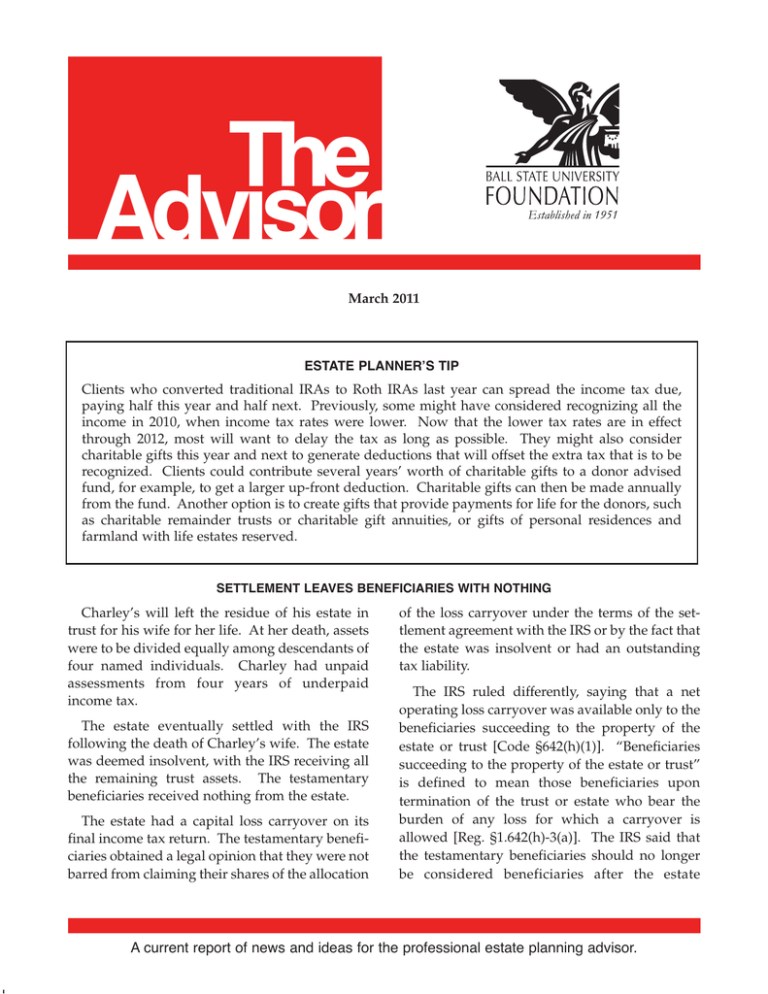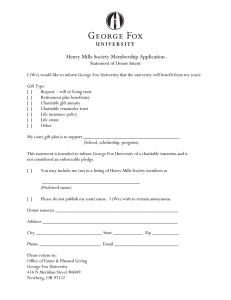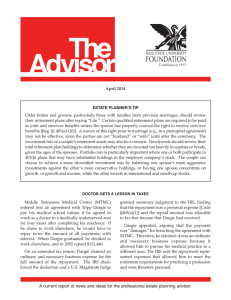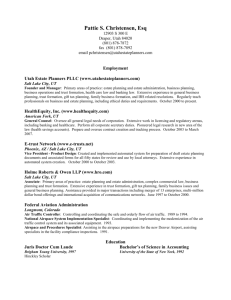The Advisor |
advertisement

The| Advisor March 2011 ESTATE PLANNER’S TIP Clients who converted traditional IRAs to Roth IRAs last year can spread the income tax due, paying half this year and half next. Previously, some might have considered recognizing all the income in 2010, when income tax rates were lower. Now that the lower tax rates are in effect through 2012, most will want to delay the tax as long as possible. They might also consider charitable gifts this year and next to generate deductions that will offset the extra tax that is to be recognized. Clients could contribute several years’ worth of charitable gifts to a donor advised fund, for example, to get a larger up-front deduction. Charitable gifts can then be made annually from the fund. Another option is to create gifts that provide payments for life for the donors, such as charitable remainder trusts or charitable gift annuities, or gifts of personal residences and farmland with life estates reserved. SETTLEMENT LEAVES BENEFICIARIES WITH NOTHING Charley’s will left the residue of his estate in trust for his wife for her life. At her death, assets were to be divided equally among descendants of four named individuals. Charley had unpaid assessments from four years of underpaid income tax. The estate eventually settled with the IRS following the death of Charley’s wife. The estate was deemed insolvent, with the IRS receiving all the remaining trust assets. The testamentary beneficiaries received nothing from the estate. The estate had a capital loss carryover on its final income tax return. The testamentary beneficiaries obtained a legal opinion that they were not barred from claiming their shares of the allocation of the loss carryover under the terms of the settlement agreement with the IRS or by the fact that the estate was insolvent or had an outstanding tax liability. The IRS ruled differently, saying that a net operating loss carryover was available only to the beneficiaries succeeding to the property of the estate or trust [Code §642(h)(1)]. “Beneficiaries succeeding to the property of the estate or trust” is defined to mean those beneficiaries upon termination of the trust or estate who bear the burden of any loss for which a carryover is allowed [Reg. §1.642(h)-3(a)]. The IRS said that the testamentary beneficiaries should no longer be considered beneficiaries after the estate A current report of news and ideas for the professional estate planning advisor. The Advisor entered into the settlement agreement. They could no longer receive anything, and any losses incurred by the estate were to the detriment of the U.S., not the beneficiaries (Ltr. Rul. 201047021). TAXPAYER ENTITLED TO DEDUCTION WHEN MOM PAID EXPENSES In 2006, Frances Field paid $24,559 to medical providers on behalf of her adult daughter, Judith Lang. She also paid $5,509 directly to the taxing body to cover Judith’s real estate taxes for that year. Judith claimed deductions for medical expenses and real estate taxes on her 2006 income tax return. The IRS said that because Judith did not personally pay the medical expenses or taxes, she was not entitled to the deductions. Judith argued that the payments made by her mother should be considered to have passed from Mrs. Field to Judith and then to the creditors. Mrs. Field claimed no deductions for the payments. The Tax Court found that the medical expense payments were made for Judith with donative intent. Mrs. Field would not be subject to the gift tax for such a gift because the payments were made directly to the providers [Code §§2503(e)(1) and (2)(B)]. Income tax treatment is not controlled by gift tax treatment, said the court, which applied PHILANTHROPY PUZZLER Terrence is an artist whose works have been commanding increasingly higher prices at art shows. He has a number of early works that he hesitates to sell, but his financial advisor has cautioned him that the value of the works will be included in his gross estate if he owns them at death. Terrence considered giving the pieces to the art museum of a local college, but discovered that his charitable deduction would be limited to his cost basis, not the fair market value of the works. He has asked if there are other options. substance over form and allowed Judith to claim the deduction. As to the real estate tax payments, gift tax regulations specifically provide that indirect gifts, such as payments made to a third party on behalf of a donee, are considered a transfer to the donee [Reg. §§25.2511-1(a), (c)(1), (h)(2) and (3)]. The court treated Judith as having received the gift from her mother and then paid the tax on her own, entitling her to the deduction (Lang v. Comm’r., T.C. Memo. 2010-286). NO DUTY ON TRUSTEE, SO NO BREACH Marie Bistersky made numerous amendments to her living trust, which provided specific bequests to friends and relatives. The residue was to pass in equal shares to five charities. In 2001, Bistersky told her grandnephew, Timothy Herlehy, that she didn’t believe the trust reflected her true wishes and the trustee was not acting in her best interests. Herlehy found that 90% of the trust’s assets were in stock, which he felt was too much for an 89-yearold. The value of the trust was about $1.2 million in mid-2001. Herlehy helped Bistersky transfer the trust to another bank. When the new trustee told her that, due to the growth of the trust, the bulk of the assets would be distributed to the charities, she indicated that was not her intent. The trustee had an analysis performed of Bistersky’s trust assets. Brian McNamara made investment recommendations on an investment form. He never met with Bistersky, was not an attorney and did not prepare trust amendments. Bistersky signed the investment form, which indicated in the comments section that the “assets will eventually go to her nephew.” Following Bistersky’s death in 2002, approximately $300,000 in specific bequests were disbursed. The remaining $950,000 was to pass to the charities. Herlehy filed suit asking for construction of a trust agreement and claiming a breach of fiduciary duty by the bank trustee and unjust enrichment on the part of the charities. He argued that the The Advisor bank failed to follow through on Bistersky’s instructions regarding changes to her trust. The circuit court granted the bank’s motion to dismiss on the grounds that the bank was prohibited from drafting amendments to trust agreements under state (Illinois) law. It was the duty of Bistersky’s attorney to draft the documents, and rules of professional conduct prohibit the attorney from receiving directions from the bank. Amendments must be directed by the settlor. Herlehy argued that Bistersky’s signature on the investment form prepared by McNamara constituted an amendment to her trust. The court said that the investment form was not a valid amendment because McNamara was not an attorney. If he had drafted an amendment, it would be in violation of the consumer fraud act and therefore invalid. The court also found no unjust enrichment on the part of the charities, noting they were “unambiguously” entitled to the residue. The Illinois Court of Appeals agreed, saying the trial court properly granted the charities’ motion for summary judgment (Herlehy v. Bistersky Trust, No. 05-CH 15199). BENEFIT TO INDIVIDUALS DESTROYS EXEMPTION A private foundation, dedicated to providing financial support to charities and individuals in need, owns and operates an art gallery. The gallery is open to the public and displays the works of local artists. The artwork is for sale, with the artists receiving a commission of 50% of the sale proceeds. Under Code §501(c)(3), an organization must be organized and operated exclusively for charitable purposes, with no part of the net earnings inuring to the benefit of any private individual. To be classified as an exempt organization, the entity must be both organized and operated for one or more exempt purposes [Reg. §1.501(c)(3)-1(a)(1)]. The IRS ruled that individual artists are directly benefiting by the exhibition and sale of their works. Because a major activity of the foundation is serving the private interests of the artists, it is not organized and operated exclusively for educational purposes and is not exempt under Code §501(c)(3) (Ltr. Rul. 201025083). TRUST GAVE, DIDN’T RECEIVE The trustee of a complex trust had the power to make distributions to charity of “such amounts from the gross income of the trust” as determined appropriate. One year, the trustee donated three parcels of land to three different charities. All of the parcels were purchased in prior years with accumulated gross income. The trust claimed a charitable deduction under Code §642(c)(1), which allows a trust an unlimited deduction for any amount of gross income paid for charitable purposes pursuant to the terms of the governing instrument. This deduction is in lieu of a charitable deduction under Code §170. The IRS ruled that the trust’s deduction was limited to its basis in the parcels, not the fair market value of the gifts. The contributions were made with property purchased in a prior year from gross income, noted the IRS. Code §642(c)(1) requires that contributions have their source in gross income. The trust may not claim a charitable contribution deduction for an amount greater than its adjusted basis, which would represent unrealized appreciation (Ltr. Rul. 201042023). PUZZLER SOLUTION Terrence could use the works to fund a charitable remainder trust that would provide him income for life. The charitable deduction would be negligible, but the trust could sell the items and reinvest the proceeds without owing any tax (Ltr. Rul. 9452026). Another alternative is to leave the works to the museum in his will. The value included in his gross estate will be washed out by an estate tax charitable deduction for fair market value [Code §2055(a)]. The Advisor TAKING CARE OF FAMILY MEMBERS NEED NOT EXCLUDE CHARITY Between 2001 and 2007, about 25% of the estates valued between $3.5 million and $20 million included charitable bequests. This compares with estates in excess of $20 million, in which the percentage including charitable bequests ranged from about 35% to 45%. These figures are significantly lower than the percentage of taxpayers who make inter vivos gifts to charity. Why aren’t there greater numbers of charitable bequests? Many clients understandably feel their first obligation is to see that the needs of family members are met, and may believe this requires leaving everything to family and nothing to the causes and institutions they supported all their lives. Philanthropic clients might be unaware that there are ways to ensure that family needs are met while still providing for charity and ensuring estate tax deductions. One solution is to make charity a contingent beneficiary or provide for disclaimers. Contingent bequest Circumstances often change between the time a will is drafted and when the testator dies. Often, a beneficiary will predecease the testator and the bequest will pass instead to the residuary estate or by intestate succession. A much better option for both the testator and charity is to designate a contingent charitable beneficiary to take only in the event the named beneficiary is not living at the testator’s death. For example, a testator might direct that “$5,000 be paid to my bother, Phil, if he is alive at my death. However, if Phil does not survive me, then the $5,000 is to pass to X charity.” Nothing will pass to charity and no deduction will be allowed unless Phil predeceases the testator. Disclaimer It’s possible for the testator to let the beneficiary decide whether or not the bequest is needed, by naming charity as an alternative beneficiary in the David W. Bahlmann, J.D. President/CEO event of a disclaimer. The beneficiary can disclaim all or a portion of the bequest. In order to qualify for the estate tax charitable deduction, the disclaimer must meet the requirements of Code §2518(b): n The disclaimer must be made in writing. n The disclaimer must be received by the executor within nine months of the date of death. The IRS has ruled that the granting of an extension for filing the estate tax return does not affect the ninemonth limit for disclaimers (Ltr. Rul. 9223051). n The disclaimant must not have accepted any interest in or benefits from the disclaimed property. n The bequest must pass to someone other than the person disclaiming, without direction by the disclaimant. If the will merely expresses the testator’s wish that the beneficiary disclaim in favor of charity, no estate tax deduction will be allowed. The IRS disallowed a deduction where the will stated, “It is my wish that the devisees . . . make a gift of my land . . . to some organization or Society to be preserved and maintained by it as a wildlife sanctuary” (Ltr. Rul. 8709027). Similarly, the courts have held that no deduction is allowed if the decedent bequeaths property to family members with precatory directions for the family members to give such property to charity [Mississippi Valley Trust Co. v. Comm’r., 72 F.2d 97 (8th Cir. 1943), Cert. Den. 293 U.S. 604]. The gift is considered to have passed not from the decedent, as required by Reg. §20.2055-1(a), but rather from the beneficiary. In that case, although there is no estate tax charitable deduction, the beneficiary will be entitled to an income tax charitable deduction. The beneficiary has the luxury of a second look to determine whether the tax savings are greater by disclaiming the property or by accepting the property and making a charitable gift. With estates up to $5 million now sheltered from tax, beneficiaries may find the income tax deduction more valuable. BALL STATE UNIVERSITY FOUNDATION P.O. Box 672, Muncie, IN 47308 (765) 285-8312 • (765) 285-7060 FAX Toll Free (888) 235-0058 www.bsu.edu/bsufoundation Philip M. Purcell, J.D. Vice President for Planned Giving and Endowment Stewardship If you know another professional advisor who would benefit from this publication, please contact The Foundation.





